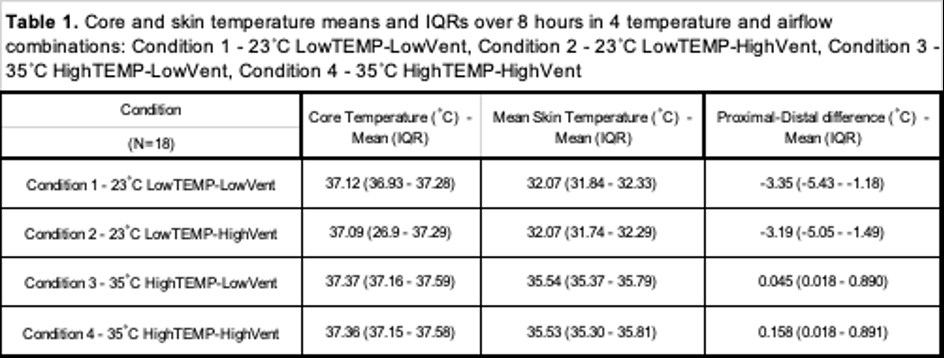Introduction
With global warming progressing, average outdoor temperatures during spring and summer are rising. These effects influence indoor environments, especially when limited mitigations are employed, like the use of fans, dehumidifiers, or air conditioners, or keeping windows closed due to environmental and personal preferences. Little has been established about the effect of high ambient temperature and low air quality on human physiological responses, as it pertains to indoor scenarios during summer. Previous research investigated isolated effects of high temperature or bad air quality, but not in combination. Moreover, the majority of heat-related thermoregulation research is conducted on active short-heat exposures rather than sedentary for long durations. To bridge these gaps, this study aimed to determine the effect of neutral vs. high ambient temperature and low vs. high airflow on the cardiovascular and thermoregulatory responses of humans in a controlled laboratory study. We hypothesize that high ambient temperature paired with low air quality (induced by low airflow) would impair physiological performance the most.
Methods
The study employed a cross-over single-blinded design. Participants were blinded to the airflow level, but due to its nature, the contrasting temperature was noticeable. 18 healthy women (n=11) and men (n=7) aged 19-39 years completed 4 non-consecutive test days. The four conditions of temperature and airflow combinations were: 23˚C LowTEMP-LowVent, 23˚C LowTEMP-HighVent, 35˚C HighTEMP-LowVent and 35˚C HighTEMP-HighVent. Individuals refrained from consuming any alcohol or engaging in high-intensity physical activity 24 hours before the measurements. Individuals were fasted for at least 12 hours before each test day.
Each test day consisted of 8 hours of exposure to one of the four conditions in a climate-controlled metabolic chamber. Participants followed the same schedule of activities (mainly sedentarily sitting) throughout each measurement day. A range of physiological and cardiovascular variables were assessed including heart rate (H10, Polar Electro, Finland), blood pressure (Mobil-o-graph, IEM, Germany), physical activity level (MOX, Maastricht Instruments, Netherlands), metabolic rates and calculated energy expenditure (Omnical Systems, Maastricht Instruments, Netherlands); amongst which mean skin temperature (14 ISO9886-defined locations (iButtons, Maxim, USA)) and core temperature (telemetric pill, Bodycap, France) are presented below. One-way repeated measures ANOVA were performed to compare mean skin temperatures and core temperatures in the four conditions.
As this study was just completed in March 2025, the analysis of the full set of outcome variables, including cardiovascular and metabolic outcomes, will be presented at the conference.
Results
Preliminary analysis showed that calculated mean skin temperatures and core temperatures were within normal ranges for healthy adults in all conditions. Mean skin temperatures and core temperatures were normally distributed (Table 1). The main effect of the conditions on mean skin and core temperatures was statistically significant and large respectively (F= 2.46e+05, p = 2e-16 and F = 17862, p <2e-16).
Conclusion
Mean skin temperatures and core temperatures were significantly different in all 4 of the high/low temperature and low/high airflow exposures over 8 hours. Further analysis is ongoing. It is anticipated that these thermophysiological responses translate to impacts on other assessed outcomes, and a complete analysis will be completed in due time.

